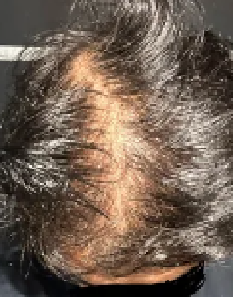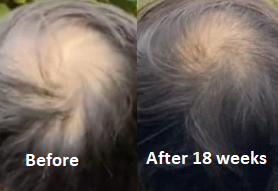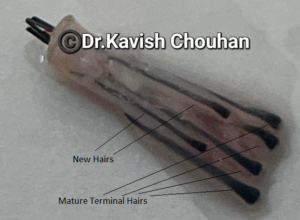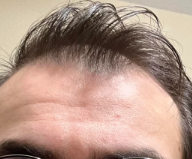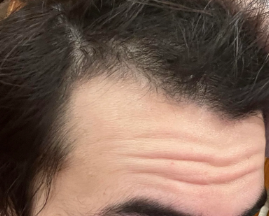Merck manufactures both medications, and they are the same except for dosage. Finasteride also comes in generics for a fraction of the cost of Propecia. For example, Costco sells a year of finasteride (generic) for $30, while some other pharmacies charge hundreds of dollars for the same drug. Compare the 5mg Proscar to the 1 mg Costco generic and then talk money with us.
http://www.snuh.org/global/en/about/newsView.do?bbs_no=4711&
[If you have any questions, you can reach me at williamrassman33@gmail.com]
I read this article, and it only addressed mouse studies. It is a long way from here to human use.
https://www.ncbi.nlm.nih.gov/pmc/articles/PMC9678755/
Please note the following statement in the article:
” Since the original introduction of low-dose oral minoxidil for this indication, reported adverse effects have been purported to be infrequent and of minor impact, with 15.1% hypertrichosis, 1.7% lightheadedness, 1.3% fluid retention, 0.9% tachycardia, 0.4% headache, 0.3% periorbital edema, and 0.2% insomnia reported in the largest retrospective multicenter study so far of 1404 patients, leading to drug discontinuation in 1.2% of patients.”
The focus on the Pericardial Effusion is significant as it appeared in a woman with a low dose of 1.25mgs/day. So the kew here is to watch for the following symptoms as they appear:
Shortness of breath, discomfort while breathing in the supine position, chest pain, lightheadedness, and swelling in the legs
Any medication can have serious side effects. Aspirin for example, has killed people from allergic reactions, bleeding from long term use, etc.. For those of you who take oral minoxidil, just be alert to the warnings in this article.
I was wondering if I should stop taking my oral minoxidil dose of 1.25mgs/day/
[If you have any questions, you can reach me at williamrassman33@gmail.com]
If you are worried about it, or if you had periods of light-headedness, or if you had rapid heart beats from the oral minoxidil, skipping a daily dose will have no negative impact on your hair.
I lost my crown hair and got transplants and SMP. My genetics didn’t impact my frontal hairline. I was lucky
Amplifica’s AMP-303 Study
Unveils New Hope for Hair Loss
Treatments
NEWS PROVIDED BY
Amplifica Holdings Group, Inc.
Sep 30, 2024, 09:02 ET
First-in-Human Trial Demonstrates Promising Results for the Treatment of Androgenetic Alopecia SAN DIEGO, Sept. 30, 2024 /PRNewswire/ — Amplifica Holdings Group Inc. (“Amplifica”), a privately held clinical-stage biopharmaceutical company, today announced results from its first-in-human trial of AMP-303, a novel intradermal injectable treatment for androgenetic alopecia (AGA), the most common form of hair loss. The randomized, double-blind, placebo-controlled, multicenter study was designed to evaluate the safety and tolerability of AMP-303, while also evaluating its efcacy. The results suggest that AMP303 has a significant potential to address hair loss after one treatment cycle.
The trial enrolled male participants aged 18 to 45 diagnosed with AGA, and stratified subjects based on the duration of their hair loss. The study divided participants into two distinct groups: those with recent onset of hair loss (3-5 years) and those experiencing more long-standing hair loss (over 10 years). A bilateral paired treatment design in the frontal temporal region was used, where each participant was randomized to receive AMP-303 on one side of the scalp and a placebo on the other, allowing for a direct comparison within individuals. This approach, combined with subject stratification by onset of hair loss, allowed for the analysis of AMP-303’s potential efectiveness across diferent timepoints and stages of hair loss while controlling for individual variability.
Key Study Findings:
-
- Safety Profile: AMP-303 was observed to be safe and well tolerated. The majority of adverse events were mild in severity and no severe adverse events were reported. Local skin reactions to intradermal injections were similar between AMP-303 and placebo, and consistent with other intradermal injections.
- Efcacy: A statistically significant percentage of study subjects (P <0.001) showed a greater than 15% increase in non-vellus hair count from baseline compared to placebo at 60 days post-treatment, and a greater than 10% increase compared to placebo at 150 days post-treatment.
- Durable Results: The study revealed that a single AMP-303 treatment cycle increased non-vellus hair count and sustained hair
density and thickness over time (150 days post treatment), a marked improvement compared to placebo. - Hair Terminalization: The study results also demonstrated AMP-303’s ability to stimulate the transition of vellus hairs into nonvellus hairs, further emphasizing the treatment’s potential for reversing hair loss.
“The ability to demonstrate measurable improvements in hair regrowth with just one treatment cycle is a breakthrough in addressing androgenetic alopecia,” said Frank Fazio, President and CEO of Amplifica. “The success of the AMP-303 study not only validates our approach but also sets the foundation for advancing additional programs in Amplifica’s pipeline. With this momentum, we are excited to to accelerate the development of new therapies targeting hair regeneration, reinforcing our commitment of developing novel treatments to address androgenetic alopecia.”
William Rassman, MD, a pioneer in hair restoration surgery and Amplifica co-founder, added, “The results observed in the frontal temporal region are particularly encouraging, as this area has traditionally been one of the most challenging to demonstrate a clinical response. AMP-303’s potential to stimulate hair regrowth in this region underscores its unique potential and sets it apart from existing therapies. Findings from this initial clinical study ofers renewed hope for patients struggling with hair loss that have historically been resistant to treatment.”
With the results from this first-in-human study, Amplifica is poised to advance AMP-303 through additional clinical trials to further explore its therapeutic potential for both men and women sufering from hair loss. The company aims to develop AMP-303 as a highly diferentiated option in the hair loss treatment landscape, which is currently limited to daily-use topical and oral therapies.
About AMP-303
AMP-303 is a proprietary, innovative formulation specifically engineered for intradermal injection to target androgenetic alopecia (AGA). Designed to stimulate hair regrowth, AMP-303 has undergone extensive pre-clinical development, including the detailed identification and understanding of its mechanism of action. Proof-of-concept testing in xenograft models has demonstrated its powerful hair growth promoting properties, laying the groundwork for its potential as a transformative treatment. Complementing this scientific advancement is a robust intellectual property portfolio, securing the innovation behind AMP-303 and reinforcing its promise as a groundbreaking solution for individuals sufering from AGA.
About Amplifica Holdings Group, Inc.
Amplifica is a rapidly emerging biopharmaceutical company focused on developing novel treatments to address androgenic alopecia (hair loss), a condition estimated to afect over 50 million men and over 30 million women in the United States alone. The Company is taking a nature-inspired scientific approach using a molecular mechanism that regrows natural hair. The Company has identified and isolated unique signaling molecules that stimulate hair follicles to regrow hair. Amplifica will be initiating product development programs and clinical trials to evaluate the safety and efcacy of its core technology as well as obtaining all applicable regulatory approvals.
For more information, please visit https://amplificabio.com.
Forward-Looking Statements
This press release contains “forward-looking statements” within the meaning of the “safe harbor” provisions of the Private Securities Litigation Reform Act of 1995. Forward-looking statements may be identified by the use of words such as “anticipate,” “believe,” “contemplate,” “could,” “estimate,” “expect,” “intend,” “seek,” “may,” “might,” “plan,” “potential,” “predict,” “project,” “target,” “aim,” “should,” “will,” “would,” or the negative of these words or other similar expressions. These forward-looking statements are based on the company’s current beliefs and expectations. Forward-looking statements include, but are not limited to, statements regarding the potential efficacy of the Company’s product candidates, the Company’s expectations with respect to development and commercialization of the Company’s product candidates, the initiation or completion of any future clinical trials. Actual results may differ from the forward-looking statements expressed by the Company in this press release and consequently, you should not rely on these forward-looking statements as predictions of future events. Forward-looking statements contained in this announcement are made as of this date, and the Company undertakes no duty to update such information except as required under applicable law.
Amplifica’s AMP-303 Study Unveils New Hope for Hair Loss Treatments 9/30/24, 6:08 AM
Contact:
Company
info@amplificabio.com
Media
EvolveMKD – Amplifica@EvolveMKD.com
SOURCE Amplifica Holdings Group, Inc
Isolation from our complex society makes a huge difference in the health of isolated individuals. See: https://www.ncbi.nlm.nih.gov/pmc/articles/PMC3835452/#:~:text=The%20cardiovascular%20deaths%20were%20made,4.4)%20respectively%20were%20much%20lower.
Heart Disease and AGA connection: Kuna Indigenous do not bald as quickly
byu/No-Lion-8243 intressless
My mother turns 69 this year and is starting to lose some hair on her temples; there aren’t many but it’s a start. She is already a highly insecure person due to her appearance and I fear that this could worsen her already fragile confidence. Are there any remedies an adult/elderly woman can take to prevent late-life baldness? If so, can she do anything to restore the lost hair?
[If you have any questions, you can reach me at williamrassman33@gmail.com]
About 50% of post-menopausal women get some type of balding. In addition to that, some get Age Related Thinning of their total hair mass which looks like thinning, but it is not necessarly a reduction of hair count on the head. The female patterned balding that occurs after menopause is because of the protective estrogens that block the genetics of balding from acting on their hair, is massively reduced. With the estrogen levels markedly reduced, their own internal testosterone has a more significant effect on their genetics. It works with their DHT to produce balding, so in some of these women, finasteride is a good drug for blocking the DHT effects on their genes for balding. For the women who get Age Related Thinnning (men also get this), little can be done.
[If you have any questions, you can reach me at williamrassman33@gmail.com]
I looked through these pictures, and they give a good overview of how people with enough money deal with their hair problems. One of the groups shown here shows a clear hair transplant, which is bad as a hair transplant must not be detectable. Can you pick out the bad hair transplant?

